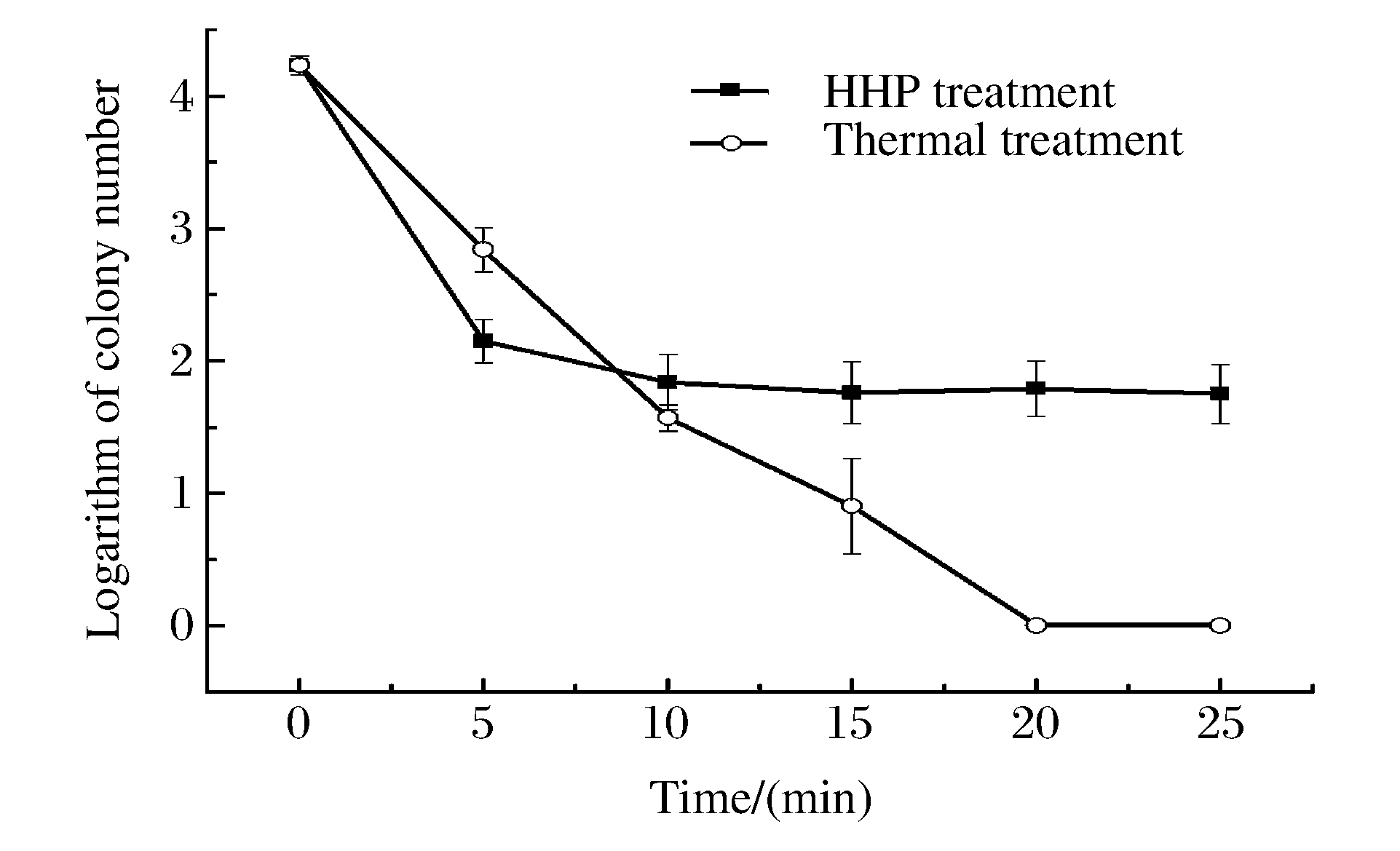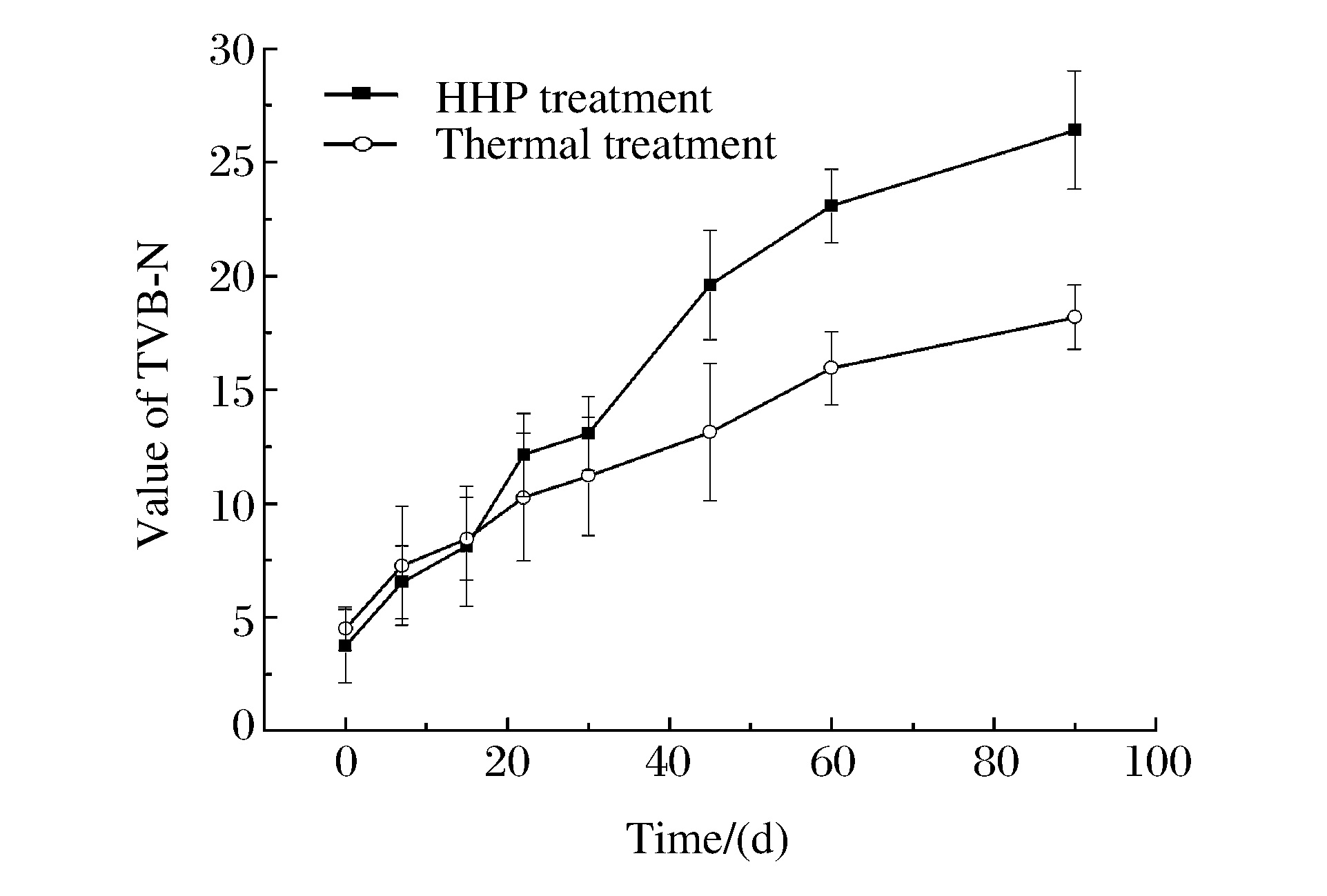Effect of Thermal Sterilization and High Hydrostatic Pressureon Shelf Life and Quality of Vinasse Shrimps
-
摘要: 为研究热和高静压杀菌对糟卤虾仁品质和货架期的影响,分别采用热和高静压(HHP)方法对糟卤虾仁样品进行处理。根据样品微生物菌落总数随着杀菌时间的变化曲线,确定较优的热和高静压杀菌条件分别为85 ℃、20 min和550 MPa、10 min。通过理化指标和感官评价对杀菌处理后的样品品质进行评价。结果表明,贮藏过程中,热和高静压杀菌组样品的pH值和水分含量均无显著变化;贮藏30 d后,热和HHP杀菌组的综合评分均低于对照组,但是HHP杀菌组样品在形态、色泽、软硬度等方面均优于热杀菌组;贮藏90 d后,HHP杀菌组样品的微生物菌落总数达到2.5×104 cfu/g,接近行业标准的上限(3.0×104cfu/g),远高于热处理组(70 cfu/g),相应地,HHP杀菌组的TVB-N值也高于热处理组。Abstract: In order to study the shelf life and quality of vinasse shrimps after sterilization, we conducted thermal and high hydrostatic pressure (HHP) treatments in the sterilization process.The curves that describe the relationship between the total plate count and the sterilizing time are obtained, showing that the optimal experiment conditions of thermal and HHP treatments are 550 MPa, 10 min and 85 ℃, 20 min, respectively.The quality of shrimp samples was evaluated by the physicochemical indexes and sensory evaluation.The results show that there are little changes in pH and moisture content of samples during storage.After 30 d storage, the comprehensive scores of HHP and thermal groups are lower than those of the control group and the sensory scores of samples in the HHP group are higher than those in the thermal group.After 90 d storage, the total plate count of samples in HHP group increases to 2.5×104 cfu/g, which is close to the industrial standard limit (3.0×104 cfu/g) and significantly higher than the thermal group.Accordingly, the TVB-N value is also higher.
-
1. 引言
南美白对虾(Penaeus vannamei)是世界三大对虾养殖种类之一[1]。目前,我国对虾加工行业还处于初级阶段,主要以鲜销或冷冻初加工为主,深加工产品较少。传统糟虾通常经过腌制、自然风干等工序制作而成,具有高盐(大于10%)、高酒精度(约为20%)、低水分含量(小于30%)的特征。在糟虾制作过程中,不仅要考虑天气状况,还要考虑地点条件、工具设置等因素。另外,小作坊式的糟虾加工企业产品品质难以得到保证,容易出现微生物含量超标的情况,极大制约了糟虾的规模化、均衡化生产。
本课题组在保留糟制食品风味及加工工艺的基础上,对传统糟卤虾仁工艺进行了改进,开发了一种新型虾仁产品[2]。该产品低盐(小于4%)、低酒精度(小于3%)、高水分含量(约为60%)的特征,优于传统虾仁。传统热杀菌技术虽然可以杀死微生物、延长货架期、钝化酶活性、改善食品品质,但是也会破坏一些热敏性物料,影响食品的口感、色泽和香味等,不能满足对虾加工的要求。近年来,新兴的食品高静压(High Hydrostatic Pressure, HHP)技术发展迅速,可以在不损害食品原有色泽、香味、口感等品质的前提下达到杀灭微生物、延长货架期、提高食品营养和功能的目的,受到人们越来越多的关注[3-4]。
在我国食品工业中,HHP技术通常应用于果蔬汁、果蔬和水果罐头的制作中,而应用于水产品加工的报道则很少。本研究利用HHP技术对糟卤虾仁进行处理,研究其对糟卤虾仁感官品质和货架期的影响,并将结果与热杀菌处理比较,以期为HHP在对虾加工中的应用提供指导。
2. 材料与方法
2.1 实验材料与试剂
实验材料:鲜活南美白对虾,购于北京四道口水产市场,系海口养殖品种。将其制成糟卤虾仁,并在0~4 ℃条件下冷藏。试剂:培养基(分析纯,北京陆桥技术有限公司)以及高氯酸、浓盐酸、氢氧化钠、甲基红、溴甲酚绿、酚酞(均为分析纯,国药集团化学试剂有限公司)。
2.2 实验仪器与设备
实验设备包括:高压处理装置(包头科发新型高技术食品机械有限责任公司)、智能型生化培养箱(宁波莱福科技有限公司)、全能型食品用分光测色仪(美国Hunter Lab颜色管理公司)、868型pH计(美国奥立龙公司)、均质拍打器(法国INTERSCIENCE公司)、九阳打浆机(九阳股份有限公司)。
2.3 实验方法
2.3.1 糟卤虾仁样品处理
将真空包装的糟卤虾仁(5只/袋)分别置于HHP处理釜和水浴锅中进行杀菌处理。考虑到自主研发的HHP处理装置的升压范围为100~700 MPa,对虾仁进行巴氏消毒的条件通常为75~85 ℃、20~50 min。因此,本实验的杀菌条件选取为在550 MPa和85 ℃下对糟卤虾仁处理5、10、15、20和25 min,并将未做任何处理的虾仁样品作为对照组。
2.3.2 微生物检测
微生物菌落总数的测定:依据GB/T 4789.2-2008,将破碎后的样品适当稀释后,倾注倒平板,于37 ℃培养48 h,计数规则采用国标方法,微生物菌落总数以cfu/g计。
2.3.3 色泽测定
采用色差仪法测定糟卤虾仁色泽:称取50 g虾仁,与30 mL蒸馏水混合后打浆,将虾仁浆液置于比色皿内,采用反射模式下的CIE-Hunter测定L*、a*、b*值,则虾仁色泽变化量ΔE可以表示为
ΔE=[(L∗−L∗0)2+(a∗−a∗0)2+(b∗−b∗0)2]1/2 (1) 式中:L*为处理后样品的亮度,L0*为对照样品的亮度,a*为处理后样品的红度,a0*为对照样品红度,b*为处理后样品的黄度,b0*为对照样品的黄度。
2.3.4 pH值测定
将待测样品用打浆机绞碎后,取20 g放入均质袋中,用蒸馏水以1:5的体积比进行稀释,并用拍打式均质器将其搅匀,取上清液,然后用pH计测定pH值。
2.3.5 水分含量测定
将待测样品用打浆机绞碎后,称取(5.0±0.5)g虾仁碎末于干燥铝盒中,放入干燥箱,在105 ℃下干燥至恒重[2]。由此,糟卤虾仁的水分含量为
w=(mbefore−mafter)/mbefore (2) 式中:w为水分含量,mbefore为干燥前质量,mafter为干燥后质量。
2.3.6 感官评价
选择10名以上感官评价员组成感官评价小组,分别对糟卤虾仁的形态、色泽、软硬度、风味等进行打分,评分标准如表 1所示。样品编号采用三维数随机组合而成,各项得分越高表示品质越好。
表 1 糟卤虾仁感官品质评价标准表Table 1. Criteria of sensory quality and evaluation for vinasse shrimpsSensory characteristics Low (2-4) Medium (5-7) High (8-10) Pattern Incomplete with multiplebreakage and deformation, andsignificantly narrowed size Almost completement, slightlydamaged deformation andnarrowed size Original form of complete shrimp with unchanged size Color Dark red Natural shrimp red anduniform brightness Natural shrimp red withbright and uniform color Softness Too soft or too hard, poorchewing and inelastic Softer or harder, moderateboth in chewingand elasticity Right balance of softnessand hardness, appropriatechewing and elasticity Flavor Delicious taste with normalodor, no peculiar smell Delicious taste withan odor of shrimps, no peculiar smell Delicious taste with rightbalance of salty and sweet, strong smell of shrimp odorand vinasse aroma 2.3.7 挥发性盐基氮值测定[2]
(1) 将10 g虾肉与90 mL高氯酸溶液(0.6 mol/L)混合打浆,均质2 min后,用滤纸过滤,滤液待用;(2)吸取10 mL硼酸吸收液(30 g/L)注入锥形瓶内,再加2~3滴混合指示剂(甲基红、溴甲酚绿),并将锥形瓶置于半微量定氮器的蒸馏冷凝管下端;(3)准确吸取5.0 mL滤液注入半微量定氮器反应室内,加入1~2滴酚酞、1~2滴硅油消泡剂、5 mL NaOH溶液,然后迅速盖塞;(4)向半微量定氮器反应室内通入水蒸汽,并对反应后的滤液蒸馏5 min;(5)用盐酸标准溶液(0.01 mol/L)将锥形瓶中的吸收液滴定至蓝紫色。
2.3.8 数据统计及图形分析
用OriginPro 7.5统计分析数据并制图。对实验数据进行方差分析(ANOVA)和差异显著性分析(SPSS 13.0),显著性水平取0.05,所有实验重复3次。
3. 结果与讨论
3.1 热和HHP处理的杀菌效果
图 1为微生物菌落总数与热和HHP杀菌时间的关系。由图 1可以看出,热和HHP处理对糟卤虾仁均有显著的杀菌效果,杀菌后,微生物指标均符合北京市地方标准《熟制水产品卫生要求》的规定(即菌落总数≤3×104 cfu/g)。样品经HHP杀菌后,微生物菌落总数由1.70×104 cfu/g逐渐下降至69 cfu/g。由于样品中耐压菌的存在,保压时间超过10 min后,菌落总数的下降不显著(P>0.05)。热杀菌后,微生物菌落总数也随着杀菌时间的增长而逐渐减少,并在约20 min时降至10 cfu/g以内,之后菌落总数基本保持稳定。因此,本实验中选取HHP杀菌的条件为550 MPa、10 min,选取热杀菌的条件为85 ℃、20 min。
3.2 热和HHP杀菌对理化指标的影响
虾仁的色泽是表征虾仁感官特征的重要参数。南美白对虾中主要的色素包括虾青素、角黄素、β类胡萝卜素和叶黄素等[5],其中虾青素含量最高,约占总色素的64%~98%[6]。因此,虾青素决定了虾仁的色泽。表 2给出了热和HHP杀菌对糟卤虾仁理化指标的影响。可以看出,热杀菌后,糟卤虾仁的亮度L*值显著减小(P < 0.05),而HHP杀菌后,虾仁L*值增大,只是变化不显著(P>0.05),说明HHP杀菌有助于提高虾仁亮度。另一方面,热和HHP杀菌后,虾仁的a*值、b*值均显著减小(P < 0.05),这可能是由于HHP和热处理破坏了细胞组织结构,使虾青素游离出来,造成a*值、b*值的下降。ΔE值反映了糟卤虾仁色泽的改变程度,ΔE值越大,虾仁色泽的变化越明显。HHP杀菌后样品的ΔE值比热杀菌小,说明HHP杀菌对虾仁色泽的破坏程度较小,有利于糟卤虾仁原有色泽的保持。
表 2 热和HHP杀菌对糟卤虾仁理化指标的影响Table 2. Effects of thermal and HHP treatments on the physicochemical properties of vinasse shrimpsTreatment pH value w/(%) L* a* b* ΔE Control 6.80±0.01b 63.13±0.58b 64.98±1.66a 11.78±0.15a 11.74±0.39a 85 ℃,20 min 6.84±0.02b 61.73±0.64a 62.67±1.70b 10.33±0.52b 10.31±0.53b 3.08 550 MPa,10 min 6.81±0.02b 62.47±0.33a 66.24±0.72a 10.69±0.45b 10.73±0.15b 1.95 Note:Different letters (a, b) in the same column indicate significant differences (P < 0.05) pH值是评价水产品鲜度的重要指标[7-8]。由表 2可以看出,经热和HHP杀菌后,糟卤虾仁的pH值均略有上升,但变化并不显著(P>0.05),说明HHP杀菌对虾仁蛋白并未造成较大影响。
糟卤虾仁水分含量的高低直接影响产品的质构特性和表观品质。由表 2可知,热和HHP杀菌后,糟卤虾仁的水分含量均减小。这是由于HHP和长时间的加热使蛋白质发生剧烈的降解反应,肌原纤维间毛细管存留水分的能力减弱[9],进而导致虾仁汁液的损失率升高。由于糟卤虾仁产品品质的好坏,主要取决于虾仁肉的含水率,而热和HHP杀菌均未造成虾仁肉水分含量显著下降(P < 0.05),因此,热和HHP杀菌都可以较好地保留糟卤虾仁产品水分含量。
3.3 热和HHP杀菌对感官品质的影响
感官评价员由10名专业人员组成,分别对糟卤虾仁样品的形态、色泽、软硬度及风味进行评价,评价结果如表 3所示。由表 3可以看出,HHP杀菌的糟卤虾仁感官品质综合评价优于热杀菌组。经热和HHP杀菌后,糟卤虾仁的形态、软硬度及风味评分均低于未处理组,但是HHP杀菌后,糟卤虾仁的色泽评分高于未处理组和热杀菌组,可能是HHP杀菌提高了糟卤虾仁亮度的缘故。综合评价结果表明,HHP杀菌的糟卤虾仁评分高于热杀菌组。
表 3 热和HHP杀菌的糟卤虾仁感官评价结果Table 3. ensory evaluation of thermal- and HHP-treated vinasse shrimpsTreatment Pattern Color Softness Flavor Evaluation Control 8.00±0.93 8.50±0.93 9.75±0.46 9.85±0.52 9.03±0.71 85 ℃,20 min 7.50±0.46 8.28±0.35 8.36±0.52 9.08±0.46 8.31±0.45 550 MPa,10 min 7.75±0.52 9.07±0.92 9.42±0.53 8.87±0.83 8.78±0.70 3.4 热和HHP杀菌对贮藏期间品质的影响
3.4.1 贮藏期间糟卤虾仁理化指标的变化
表 4为贮藏(4 ℃)期间糟卤虾仁理化指标的变化情况。由表 4可知,贮藏90 d后,热和HHP杀菌组样品的微生物菌落总数分别增加至70和2.5×104cfu/g,均维持在标准范围内,但是HHP组样品的菌落总数已经接近标准的上限(3.0×104cfu/g)。Koseki等人[10]提出,HHP杀菌会杀死部分微生物营养体,也会导致部分微生物受伤,使其无法增殖,受伤细胞自我修复以后,可以恢复增殖。因此,相比于HHP杀菌,热杀菌能够杀灭更多的微生物营养体,使得只有少量的微生物在贮藏期间缓慢生长。
表 4 贮藏期间糟卤虾仁理化指标变化Table 4. Changes in the physico chemical properties of vinasse shrimps during storageTime/(d) Colony number pH value w/(%) 550 MPa 85 ℃ 550 MPa 85 ℃ 550 MPa 85 ℃ 0 (3.6±1.60)×10 10 6.83±0.03 6.87±0.02 67.27±0.40 67.40±0.12 7 (8.0±0.85)×10 (0.6±0.23)×10 6.82±0.01 6.85±0.01 67.80±0.35 66.80±0.35 15 (7.0±1.63)×10 (0.3±0.10)×10 6.89±0.03 6.89±0.01 67.30±0.23 66.93±0.20 22 (9.0±0.81)×10 (1.5±1.05)×10 6.88±0.03 6.87±0.01 66.80±0.29 63.89±0.12 30 (4.1±0.81)×102 (1.3±0.58)×10 6.88±0.01 6.86±0.01 66.87±0.27 61.13±0.43 45 (6.5±1.20)×102 (1.8±0.83)×10 6.83±0.01 6.83±0.01 65.87±0.42 60.80±0.67 60 (2.9±0.50)×103 (3.0±1.00)×10 6.85±0.01 6.88±0.01 67.07±0.12 62.13±0.42 90 (2.5±0.35)×104 (7.0±0.61)×10 6.82±0.01 6.84±0.01 64.93±0.50 61.93±0.61 pH值是反映水产品鲜度和腐败变质程度的重要指标,pH值的变化与蛋白质降解、微生物生长繁殖等因素相关。热杀菌后,糟卤虾仁样品的pH值在整个贮藏期间变化平缓,说明热杀菌可以有效杀灭糟卤虾仁中的微生物。HHP杀菌后,在贮藏前20 d,糟卤虾仁的pH值略有增加,这是由于蛋白质被分解为小分子的胺类物质而造成的[11];贮藏后期,样品中存留的微生物利用虾肉中的碳水化合物等营养成分生成乳酸、醋酸等有机酸,使得pH值减小。贮藏90 d后,热和HHP杀菌样品的pH值均在6.80以上,说明糟卤虾仁产品仍未发生酸败现象。
Bertram等人[12]指出,肉制品中存在3种不同形式的水,分别是结合水、中间水和自由水,蛋白质空间结构的破坏,会导致食品中水分与食品成分结合紧密度的降低,因此,结合水向自由水转化,使得自由水所占的比例逐渐增大。由表 4可知,随着贮藏时间的延长,糟卤虾仁样品中的水分含量总体呈现下降的趋势。贮藏前15 d,水分含量变化比较平缓,贮藏30 d后,相比于HHP杀菌组,热杀菌组中样品的水分含量出现显著下降(P < 0.05),说明热杀菌对蛋白与水分所构成空间网状结构的破坏程度较HHP杀菌严重,加剧了水分的流失。贮藏60 d时,样品内水分含量的上升可能是由于水分游离出来还未蒸发所致,之后,样品中的水分含量变化不大,说明结合水向自由水转变程度降低。
3.4.2 贮藏期间TVB-N值的变化
挥发性盐基氮(TVB-N)是指动物性食品在腐败过程中由于酶和细菌作用使蛋白质分解产生的氨以及低级胺类等碱性含氮物质。在水产品中,TVB-N通常作为评价鲜度的指标。当100 g的样品的TVB-N值小于35 mg时,则可以认为样品是新鲜的。由图 2可知,TVB-N值随着贮藏时间的延长逐渐增大,与Shamshad[13]和Jaffres等人[14]的研究结果类似。微生物是导致水产品腐败变质的主要原因。水产品生物胺的产生与微生物含量正相关,而TVB-N与这些生物胺的量存在一定的相关性[15]。由于在相同贮藏条件下,与热杀菌后的糟卤对虾样品相比,HHP杀菌后,样品携带更多的微生物,因此,HHP杀菌的虾仁TVB-N值上升较快,而热杀菌的虾仁TVB-N值上升较慢。
3.4.3 贮藏期间糟卤虾仁的感官评定
贮藏期内的感官评定是判定虾仁产品贮藏期间品质好坏的重要方式。表 5为感官评价员对贮藏30 d的糟卤虾仁样品从形态、色泽、软硬度和风味进行感官评价的结果。由表 5可以看出,HHP杀菌组虾仁样品肌肉质地得到改善,更受喜爱。同时,HHP杀菌对虾仁色泽也有改善作用,可能是因为HHP杀菌后虾体变亮,红度值较大。热杀菌组的各项评分虽有下降,但仍在可接受范围内。
表 5 贮藏期间糟卤虾仁感官评价结果Table 5. Sensory evaluation of vinasse shrimps during storageTreatment Pattern Color Softness Flavor Evaluation 85 ℃, 20 min 7.75±0.62 7.71±0.35 7.43±0.22 8.29±0.60 7.79±0.45 550 MPa, 10 min 7.75±0.53 9.07±0.70 9.54±0.56 8.57±0.41 8.73±0.55 4. 结论
(1) 热杀菌的效果优于HHP杀菌。HHP杀菌后,糟卤虾仁的微生物菌落总数由1.70×104 cfu/g降至69 cfu/g,热杀菌组则减小至10 cfu/g以内。根据微生物菌落总数随着杀菌时间的变化曲线,选取HHP杀菌的条件为550 MPa、10 min,热杀菌的条件为85 ℃、20 min。
(2) 热和HHP杀菌后,糟卤虾仁pH值、水分含量的变化不显著(P>0.05)。经感官评定,HHP杀菌组的糟卤虾仁样品在形态、色泽、软硬度以及综合评分方面均优于热杀菌组。
(3) 贮藏30 d后,对样品进行评分发现,HHP杀菌组的糟卤虾仁样品在色泽、软硬度、风味、综合评分方面高于热杀菌组。贮藏90 d后,HHP杀菌的糟卤虾仁微生物菌落总数增加至2.5×104 cfu/g,接近行业标准的上限(3.0×104 cfu/g),且HHP杀菌组样品的TVB-N值也高于热杀菌组。
-
表 1 糟卤虾仁感官品质评价标准表
Table 1. Criteria of sensory quality and evaluation for vinasse shrimps
Sensory characteristics Low (2-4) Medium (5-7) High (8-10) Pattern Incomplete with multiplebreakage and deformation, andsignificantly narrowed size Almost completement, slightlydamaged deformation andnarrowed size Original form of complete shrimp with unchanged size Color Dark red Natural shrimp red anduniform brightness Natural shrimp red withbright and uniform color Softness Too soft or too hard, poorchewing and inelastic Softer or harder, moderateboth in chewingand elasticity Right balance of softnessand hardness, appropriatechewing and elasticity Flavor Delicious taste with normalodor, no peculiar smell Delicious taste withan odor of shrimps, no peculiar smell Delicious taste with rightbalance of salty and sweet, strong smell of shrimp odorand vinasse aroma 表 2 热和HHP杀菌对糟卤虾仁理化指标的影响
Table 2. Effects of thermal and HHP treatments on the physicochemical properties of vinasse shrimps
Treatment pH value w/(%) L* a* b* ΔE Control 6.80±0.01b 63.13±0.58b 64.98±1.66a 11.78±0.15a 11.74±0.39a 85 ℃,20 min 6.84±0.02b 61.73±0.64a 62.67±1.70b 10.33±0.52b 10.31±0.53b 3.08 550 MPa,10 min 6.81±0.02b 62.47±0.33a 66.24±0.72a 10.69±0.45b 10.73±0.15b 1.95 Note:Different letters (a, b) in the same column indicate significant differences (P < 0.05) 表 3 热和HHP杀菌的糟卤虾仁感官评价结果
Table 3. ensory evaluation of thermal- and HHP-treated vinasse shrimps
Treatment Pattern Color Softness Flavor Evaluation Control 8.00±0.93 8.50±0.93 9.75±0.46 9.85±0.52 9.03±0.71 85 ℃,20 min 7.50±0.46 8.28±0.35 8.36±0.52 9.08±0.46 8.31±0.45 550 MPa,10 min 7.75±0.52 9.07±0.92 9.42±0.53 8.87±0.83 8.78±0.70 表 4 贮藏期间糟卤虾仁理化指标变化
Table 4. Changes in the physico chemical properties of vinasse shrimps during storage
Time/(d) Colony number pH value w/(%) 550 MPa 85 ℃ 550 MPa 85 ℃ 550 MPa 85 ℃ 0 (3.6±1.60)×10 10 6.83±0.03 6.87±0.02 67.27±0.40 67.40±0.12 7 (8.0±0.85)×10 (0.6±0.23)×10 6.82±0.01 6.85±0.01 67.80±0.35 66.80±0.35 15 (7.0±1.63)×10 (0.3±0.10)×10 6.89±0.03 6.89±0.01 67.30±0.23 66.93±0.20 22 (9.0±0.81)×10 (1.5±1.05)×10 6.88±0.03 6.87±0.01 66.80±0.29 63.89±0.12 30 (4.1±0.81)×102 (1.3±0.58)×10 6.88±0.01 6.86±0.01 66.87±0.27 61.13±0.43 45 (6.5±1.20)×102 (1.8±0.83)×10 6.83±0.01 6.83±0.01 65.87±0.42 60.80±0.67 60 (2.9±0.50)×103 (3.0±1.00)×10 6.85±0.01 6.88±0.01 67.07±0.12 62.13±0.42 90 (2.5±0.35)×104 (7.0±0.61)×10 6.82±0.01 6.84±0.01 64.93±0.50 61.93±0.61 表 5 贮藏期间糟卤虾仁感官评价结果
Table 5. Sensory evaluation of vinasse shrimps during storage
Treatment Pattern Color Softness Flavor Evaluation 85 ℃, 20 min 7.75±0.62 7.71±0.35 7.43±0.22 8.29±0.60 7.79±0.45 550 MPa, 10 min 7.75±0.53 9.07±0.70 9.54±0.56 8.57±0.41 8.73±0.55 -
[1] 崔宏博, 薛勇, 宿玮, 等.即食南美白对虾贮藏过程中水分状态的变化研究[J].中国食品学报, 2012, 12(6):198-203. doi: 10.3969/j.issn.1009-7848.2012.06.029CUI H B, XUE Y, SU W, et al.Study on moisture status change of ready-to-eat shrimp during storage[J].Journal of Chinese Institute of Food Science and Technology, 2012, 12(6):198-203. doi: 10.3969/j.issn.1009-7848.2012.06.029 [2] 李瑶. 高静压加工糟卤虾仁工艺优化[D]. 北京: 中国农业大学, 2014.LI Y. The process optimization of high hydrostatic pressure processing vinasse shrimps[D]. Beijing: China Agricultural University, 2014. [3] AHMED J, RAMASWAMY H S.Effect of high-hydrostatic pressure and concentration of rheological characteristics of xanthan gum[J].Food Hydrocolloid, 2004, 18(3):367-373. doi: 10.1016/S0268-005X(03)00123-1 [4] KNUDSEN J C, OTTE J, OLSEN K, et al.Effect of high hydrostatic pressure on the conformation of β-lactoglobulin A as assessed by proteolytic peptide profiling[J].Int Dairy J, 2002, 12(10):791-803. doi: 10.1016/S0958-6946(02)00078-X [5] GOOWWIN T W.The biochemistry of the carotenoids[M].2nd ed.London:Chapman & Hall, 1984. [6] LATSCHA T. The role of astaxanthin in shrimp pigmentation[C]//Advances in Tropical Aquaculture. Tahiti, French Polynesia, 1989, 9: 319-325. [7] KURAL A G, CHEN H Q.Conditions for a 5-log reduction of vibrio vulnifcus in oysters through high hydrostatic pressure treatment[J].Int J Food Microbiol, 2008, 122(1):180-187. [8] KURAL A G, SHEARER A E H, KINGSLEY D H, et al.Conditions for high pressure inactivation of vibrio, parahaemolyticus in oysters[J].Int J Microbiol, 2008, 127(1):1-5. http://europepmc.org/abstract/med/18547664 [9] AASLYNG M D, BEJERHOLM C, ERTBJERG P, et al.Cooking loss and juiciness of pork in relation to raw meat quality and cooking procedure[J].Food Qual Prefer, 2003, 14(4):277-288. doi: 10.1016/S0950-3293(02)00086-1 [10] KOSEKI S, YAMAMOTO K.Recovery of Escherichia coli ATCC 25922 in phosphate buffered saline after treatment with high hydrostatic pressure[J].Int J Food Microbiol, 2006, 110(1):108-111. doi: 10.1016/j.ijfoodmicro.2006.01.039 [11] 陈丽娇, 郑明锋.大黄鱼海藻酸钠涂膜保鲜效果研究[J].农业工程学报, 2003, 19(4):209-211. doi: 10.3321/j.issn:1002-6819.2003.04.051CHEN L J, ZHENG M F.Freshness-keeping effect of large yellow croaker by coating with sodium alginate solution[J].Transactions of the Chinese Society of Agricultural Engineering, 2003, 19(4):209-211. doi: 10.3321/j.issn:1002-6819.2003.04.051 [12] BERTRAM H C, SUNE D, ANDERS H K, et al.Continuous distribution analysis of T2 relaxation in meat-an approach in the determination of water-holding capacity[J].Meat Sci, 2002, 60(3):279-285. doi: 10.1016/S0309-1740(01)00134-6 [13] SHAMSHAD S I, RIAZ M, ZUBERI R, et al.Shelf life of shrimp (Penaeus merguiensis) stored at different temperatures[J].J Food Sci, 1990, 55(5):1201-1205. doi: 10.1111/jfds.1990.55.issue-5 [14] JAFFRES E, SOHIER D, LEROI F, et al.Study of the bacterial ecosystem in tropical cooked and peeled shrimps using a polyphasic approach[J].Int J Food Microbiol, 2009, 131(1):20-29. doi: 10.1016/j.ijfoodmicro.2008.05.017 [15] ANDERSON A K.Biogenic and volatile amine-related qualities of three popular fish species sold at Kuwait fish market[J].Food Chem, 2008, 107(2):761-767. doi: 10.1016/j.foodchem.2007.08.094 -







 下载:
下载:



 下载:
下载:





